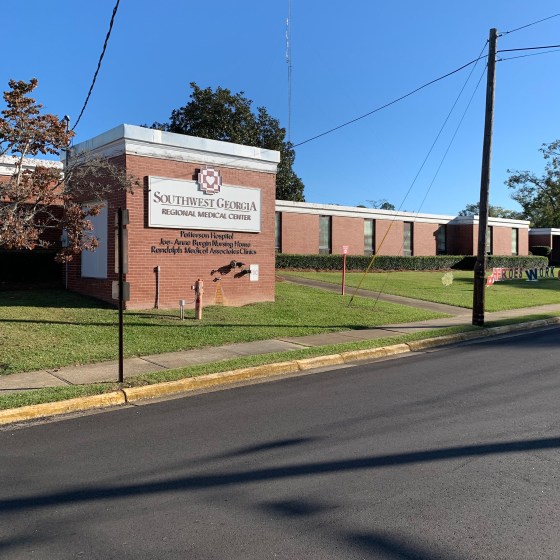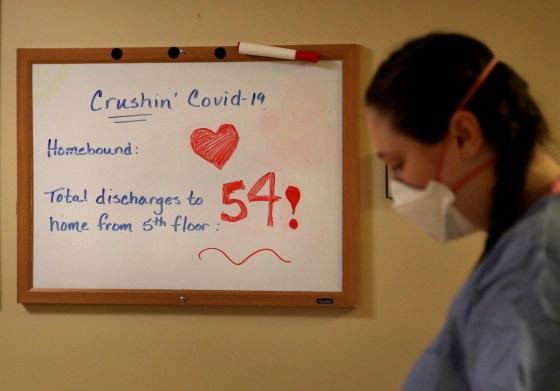Rural U.S. Hospitals Are on Life Support as a Third Wave of COVID-19 Strikes
When COVID-19 hit the Southwest Georgia Regional Medical Center in Cuthbert, a small rural town in Randolph County, in late March, the facility—which includes a 25-bed hospital, an adjacent nursing home and a family-medicine clinic, was quickly overwhelmed. In just a matter of days, 45 of the 62 nursing home residents tested positive. Negative residents were isolated in the hospital while the severely ill patients from both the nursing home and the local community were transferred to other better-equipped facilities.
“We were trying to get the patients out as fast as possible,” says Steve Whatley, Southwest Georgia Regional’s board chairman. “It was a daily nightmare.”
The scramble was exacerbated by a dire lack of medical necessities. Employees had to diligently conserve personal protective equipment. The hospital had no ventilators. And the nursing home’s air systems had to be retrofitted to create negative-pressure rooms to contain the airborne virus particles. Making matters even worse, one of the county’s only two physicians became ill with a severe respiratory disease unrelated to the coronavirus, while the other had an unexpected surgery requiring eight weeks of recovery time. Nurse practitioners stepped up as Southwest Georgia Regional waited for backup from neighboring health care organizations. More than 30 of 200 employees stopped working out of fear or because they got sick; the state of Georgia provided six nurses and two respiratory therapists as emergency relief. Despite the heroic efforts of the center’s staff, more than a dozen nursing home residents died within eight weeks of the virus’ arrival, though it’s unclear how many were directly due to COVID-19.
The ordeal left Southwest Georgia Regional—which was already struggling to survive—in financial shambles, as costs related to the coronavirus greatly exceeded revenues. It will permanently close on Oct. 22, making it the seventh Georgia hospital to do so since 2010. After Southwest Georgia Regional closes, Randolph County will become the 55th in the state to have no hospital at all. Residents will need to drive 30 minutes west and across the state line to Eufaula, Ala. or 50 minutes east to Albany, Ga. for care.
The middle of a pandemic is a bad time for a hospital to close. Yet Southwest Georgia Regional isn’t unique. Hospitals in St. Paul, Minn., Chicago, Houston and Philadelphia have recently closed or are set to do so soon. And in rural areas of the country, where hospitals often have enough beds for just a few dozen patients, 15 facilities have shuttered this year as of Oct. 20, including 11 since March, according to the Cecil G. Sheps Center for Health Services Research at the University of North Carolina at Chapel Hill. There may be as many as 18 such closures in 2020, topping last year’s record high. The hospitals in the worst financial shape generally have one thing in common: they serve the country’s most vulnerable people, who rely on Medicare and Medicaid or who are poor and uninsured.
THE DEATH KNELL
When the pandemic struck, just about all hospitals took a financial hit. Cash-cow elective surgeries were suspended for weeks to curb viral spread. Hospitals that weren’t treating many COVID-19 patients simply ate that loss, while expenses skyrocketed at those that were, due to high demand for personal protective equipment and labor costs. A September report from hospital insights firm Kaufman Hall found that operating margins for U.S. hospitals were down 89% in the first eight months of the year, excluding federal relief funds.
Southwest Georgia Regional was on life support well before the pandemic. Coming into 2020, the 73-year-old hospital needed over $10.5 million for structural improvements, including a new roof, asbestos abatement and an upgraded HVAC system. It also needed new medical equipment and a surgeon to replace one who was retiring. Such investments were a pipedream for the facility, which hasn’t been profitable in many years. COVID-19 was simply the “death knell,” says Whatley. “That pushed us over the cliff.”
The hospital’s fall into disrepair is in large part a failure of the U.S. medical payer system. Health care facilities are compensated by insurers based on a patient’s coverage status. They can command rates from private insurers that are twice as high on average as Medicare, according to a recent analysis from the Kaiser Family Foundation.
“If a hospital is efficient, it can make money on Medicare, but it usually breaks even,” says Nancy Kane, adjunct professor in the department of health policy and management at the Harvard T.H. Chan School of Public Health. “The secret to financial success is having privately insured people.”
Large hospital systems, including the country’s most renowned clinics and university hospitals, have so many privately insured patients that they can more than subsidize their Medicare and Medicaid patients. Those profits are then reinvested to expand clinical services, which, in turn, attract even more privately-insured patients. Nearly all publicly traded hospitals tracked by the news outlet Axios posted a net profit in their most recent quarter.
But in Southwest Georgia Regional’s Randolph County, about one in three residents live in poverty, according to the U.S. Census Bureau, with a median household income of $31,000. Many don’t even have government coverage, leading to years upon years of care that goes unpaid for. The hospital had to cut costs as much as possible just to keep the lights on. About 15 years ago, the facility stopped delivering babies and it gradually reduced surgeries to a small offering of procedures, such as hernia treatments and tonsillectomies. Over time, Southwest Georgia Regional was left in the dust. It simply didn’t have the means to invest in the technology and personnel to be competitive. And people in the community with the means to seek treatment elsewhere wouldn’t consider going to the aging facility, contributing to its downward spiral.
THE RURAL PROBLEM
More than 20% of rural hospitals in the U.S. like Southwest Georgia Regional are at high risk of closing, according to a 2019 study from consulting firm Navigant, now a part of Guidehouse. In some states, like Georgia, Alabama, and Mississippi, it’s more than 40%. At the same time, the analysis found that nearly two-thirds of the country’s at-risk hospitals are essential to their communities.
Hospital consolidations and closures are not always a bad thing, says Kane. Fewer hospitals are needed as surgical procedures become less invasive, and behavior changes (like people giving up smoking) reduce demand for acute medical interventions. She sees opportunity in replacing underutilized hospitals with telehealth and community wellness programs that help to keep people from going to the hospital in the first place. “If the hospital is 10% occupied, then it’s not serving the community,” she says.
In cities, there’s a good chance that other nearby hospitals can absorb a closed hospital’s patients, or that new health care centers will emerge. But when a rural hospital disappears, it doesn’t always lead to something better. There were 39 urban hospital closures in 2018 and 2019, offset by 22 openings. Outside urban areas, there were 30 closures and just a single opening over the same period, according to a March report from the Medicare Payment Advisory Commission, a nonpartisan congressional agency.
The rate of rural hospital closures is accelerating in part due to rapidly declining patient volumes. Nearly two-thirds of rural counties experienced population declines between 2010 and 2019, according to a Pew analysis of U.S. Census data. Meanwhile, rural residents with some financial means and reliable transportation will often pass over their local hospital, opting to travel to the nearest city for non-urgent medical procedures. Because it’s often the poorest and least mobile residents who rely on their local hospital for care, they will be the ones most adversely impacted when their local hospitals shut down. If these trends continue, the consequences could be serious. One analysis from the National Bureau of Economic Research found that rural hospital closures increase inpatient mortality by 8.7% for time-sensitive conditions such as stroke, asthma and heart attacks, while urban closures have no measurable impact.
“When a hospital closes, you notice when an emergency department was needed—a child choking, a heart attack, a motor vehicle accident. Those are immediate effects,” says Mark Holmes, director at the Sheps Center at UNC. “But the role of the hospital is to address the health of the community. Access problems in rural America leads to everything from later stage cancer to low birth weight.”

The hospital at the Southwest Georgia Regional Medical Center is considered “critical access,” a designation usually reserved for facilities offering 24/7 emergency care that have 25 beds or fewer and are at least 35 miles from another hospital. It has often been used as a place to stabilize patients before sending them to other facilities. Going forward, it may not just be cardiac arrest and car-accident patients who won’t get that critical interim care, but potentially another wave of COVID-19 victims. More than a third of Randolph County residents are considered obese, while one in five smoke—both of which make people more vulnerable to the coronavirus. Rural Americans more broadly tend to be older and sicker than their urban counterparts. That’s an unsettling thought, given that this virus tends to be deadlier for the most vulnerable among us. Moreover, COVID-19 has recently been working its way into rural states like Nebraska and Montana with devastating effect.
THE LIFEBOAT
Several federal stimulus packages have been made available to hospitals since early in the pandemic. The CARES Act set aside $175 billion for hospitals, physicians, pharmacies and medical clinics hit with financial stresses. Hospitals have received $70 billion of the $124 billion disbursed, according to an October analysis from the American Hospital Association. These funds do not need to be repaid. Furthermore, the Department of Health and Human Services in March expanded its Medicare Accelerated and Advance Payment (AAP) program, which has allocated $85 billion in hospital loans thus far. However, these funds need to be paid back.
Hospital administrators and industry analysts have widely praised the relief funds. The Randolph County hospital authority, for example, received $4.1 million in CARES Act money that allowed the Southwest Georgia Regional Medical Center to install negative air pressure rooms, boost staffing and buy protective equipment while covering lost revenues.

As it stands, hospitals that took AAP dollars will have to repay them. That may not be a problem for larger hospital systems that had cash on hand prior to the pandemic and have recently seen ER visits and outpatient surgeries tick back up. But for hospitals running on razor margins, repayment could prove challenging, if not impossible. The American Hospital Association has asked for loan forgiveness, but so far Congress has only delayed the start of the repayment period to next year. The money “offered rural hospitals that were adrift in financial distress a lifeboat, which has been running out of air,” says Holmes, who notes there were no rural hospital closures in May and June. “The question is, now what?”
Some hospital associations are calling on state lawmakers to help, in part by expanding Medicaid. An August 2018 report from the U.S. Government Accountability Office found that rural hospitals in states that had increased Medicaid eligibility under the 2010 Affordable Care Act (ACA) saw fewer closures than those that didn’t. While Medicaid payments don’t always fully cover costs, a growing body of research indicates that it reduces the debts associated with uncompensated care.
Georgia, Mississippi and Alabama are among a dozen states that have not expanded Medicaid, despite having the highest percentage of financially at-risk hospitals among all states with five or more rural hospitals. The reluctance largely stems from the ACA’s unpopularity among Republicans. To make the idea more palatable, the Mississippi Hospital Association has proposed an ACA-style expansion plan like the one passed in Indiana under then-governor Mike Pence, who’s now the vice president. Still, the topic remains politically fraught.
Some hospital administrators have tried to take survival into their own hands by becoming part of a larger hospital system or, more unusually, joining forces with regional competitors. In Mississippi, for instance, Magee General Hospital—a 44-bed facility in Magee, Miss. that was in its 19th month of chapter 11 bankruptcy when the coronavirus hit—had partnered in April 2019 with nearby Covington County Hospital. The efficiency-boosting move helped Magee emerge from bankruptcy in late May.
“It was an opportunity to grow,” says Gregg Gibbes, who now serves as CEO of both hospitals, plus another that joined the partnership in July. But he cautions that smarter business practices can only go so far if the pandemic worsens. “Financially, we’re still in a state of uncertainty,” he says. “If elective procedures are shut down in the future, that will certainly have some far-reaching effect. It could cripple us permanently if we have to do that again.”
Indeed, collaboration is no guarantee of survival. Southwest Georgia Regional Medical Center has been managed by Phoebe Putney Memorial Hospital, a more financially stable hospital about 50 minutes away since 1996. Southwest Georgia Regional paid only $5,000 a year for the arrangement and it reaped benefits including no-interest loans from Phoebe. At the height of the coronavirus surge, Phoebe provided critical resources to maintain staff levels, and even shut down its own hospice center to send staffers to Southwest Georgia Regional. “It was unbelievable the job that the staff and the administration did,” says Whatley. “Our success was because of them.”
And yet, it wasn’t enough to save the hospital at the Southwest Georgia Regional Medical Center. Given the circumstances, it’s hard to imagine any intervention that could. “Eventually, you got to reinvest and have capital and we didn’t have the luxury,” says Whatley. “It’s a sad day for our county.”
View original article
Contributor: Emily Barone

